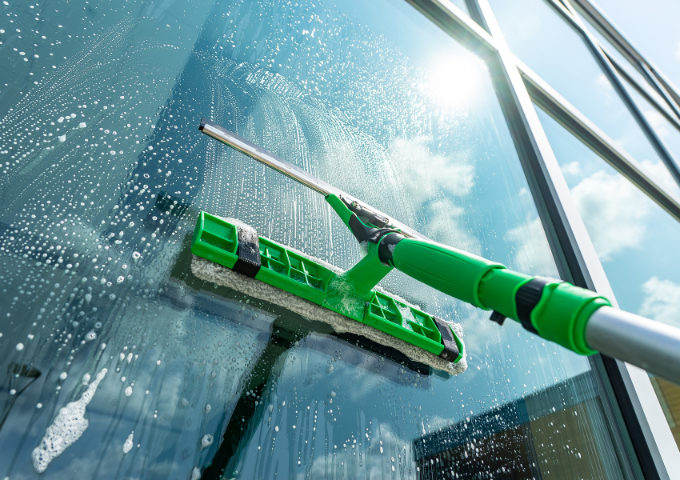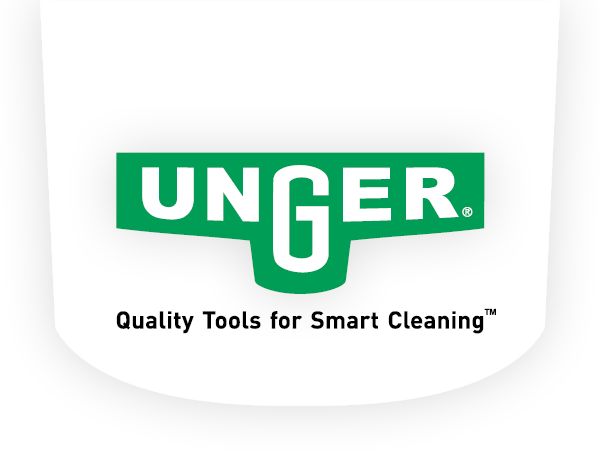NEW! Powerful Nano Filtration with Unger's HydroPower® Nano See The Product

Commercial Window Cleaning Done Right: Two Sides to Every Window
Key Takeaways
- Windows can still look dirty after cleaning if only one side is cleaned.
- Clean glass improves first impressions, natural light, and employee well-being.
- One-sided cleaning wastes effort and increases long-term costs.
- The best solution is using tools (like extension poles with squeegees, scrapers, and microfiber pads) that work for both inside and outside.
- A window is only as clean as its dirtiest side—both must be maintained for clear, lasting results.
You’ve invested in keeping your facility’s windows clean, whether by outsourcing professional services or purchasing high-quality window cleaning tools. But even after that effort, windows can still look dirty. When the light hits just right, streaks, smudges, or a dull haze show through. It’s disappointing to say the least, and it usually comes down to one simple truth: if you didn’t clean—or didn’t properly clean—the inside of the window, a window is only as clean as its dirtiest side.
Cleaning only the inside or only the outside may seem like progress, but it leaves the job half done and the results lackluster. Truly clean and clear windows require equal attention to both sides of the glass. When you maintain both inside and outside surfaces, windows deliver the clarity and professional appearance that make a real impact.
Why Can Windows Still Look Dirty After Cleaning?
It happens… you’ve spent the time and effort to professionally clean your windows, only to step back to see that they still look less than perfect. Here are the main reasons why this happens:
- One-Sided Cleaning: Even if the inside windows sparkle, smudges, hard water stains, or film on the exterior can make the whole window look cloudy. The same goes if you only clean the outside.
- Light and Angles: Windows that look spotless in shade can suddenly reveal streaks or haze when the sun shifts across the sky or when overhead lights come on in the evening. The angle of light often exaggerates even small residues, frustrating anyone who has just finished cleaning.
- High-Traffic Touch Points: Interior glass, especially in busy lobbies, entry doors, and hallways that see heavy foot traffic, tends to accumulate fingerprints, handprints, and smudges simply because of its accessibility. Given the amount of foot traffic these areas see, even when freshly cleaned, windows and glass can quickly appear like they haven’t been cleaned at all.
- Outdoor Elements: Exterior windows have nowhere to hide from the environment. Rainwater can leave mineral deposits behind, while pollen, dust, pollution, and vehicle exhaust can all build up quickly on glass. Even freshly washed windows may quickly look dull again if you’re not addressing outdoor window cleaning regularly.
- Condensation and Humidity: On the inside, HVAC systems, humidity changes, or poor ventilation can create fogging or leave behind residue. This often happens during seasonal temperature shifts, like in the summer when cool indoor air meets hot, humid outdoor air, or in the winter when warm interior air hits a cold window surface. HVAC systems, kitchens, restrooms, or poorly ventilated areas can also add moisture to the air, creating fogging or leaving behind a thin film on the glass.
- Ineffective Cleaning Methods: Relying on a spray bottle and rag may seem convenient, but it often leaves streaks, lint, or uneven coverage behind. These methods aren’t designed for professional results and can make windows appear only partially clean, even right after they’ve been “finished.”
Why Does Cleaning Both Sides Matter?
Putting the above factors together, the takeaway is simple: cleaning just one side of a window is only half the job. Both inside and outside surfaces need attention to deliver the clear, professional finish people expect.
1. First Impressions:
55% of first impressions are made by what we see, making the presentation and cleanliness of a property extremely important. Considering that windows are one of the first things you see when entering a building, streaks, spots, or haze can send the message that the space isn’t well cared for. Clean, clear glass instantly elevates the appearance of the property and reflects professionalism.
2. Occupant Experience:
People working inside may rely on windows for natural light. Clean windows maximize natural light, which helps reduce eye strain, minimize reliance on harsh artificial lighting, and create a brighter, more comfortable work environment. They also support well-being by boosting exposure to natural sunlight, which promotes vitamin D production, improves mood, and helps employees feel more energized. Clean windows also make a strong impression on customers, retail visitors, and office clients, allowing the space to feel more welcoming and well cared for.
How Can You Avoid the “Half-Clean Window” Problem?
Scheduling regular cleanings and training staff are essential, but the most significant difference comes from using the right commercial cleaning tools. Indoor windows require precision solutions that prevent water runoff, such as extension poles, microfiber pads, and indoor window kits. Exterior glass benefits from professional squeegees and waterfed pole systems that deliver streak-free clarity safely from the ground. Equipping teams with tools designed for both sides of the glass eliminates the “half-clean” effect, saves time, and ensures consistently clear results from every angle.
Choose Tools That Work for Both Sides
One of the most important factors to avoid “half-clean” windows is equipping your team with tools that can effectively clean both interior and exterior windows. Tools such as adjustable extension poles are incredibly versatile. They allow cleaners to reach high interior windows without ladders (up to 60 feet) and safely tackle exterior surfaces from the ground.
What makes these poles so effective is the wide range of interchangeable attachments available. Commercial glass squeegees, scrapers, and microfiber based cleaning pads can all be mounted on the same pole, giving professionals the ability to scrub, wipe, and polish windows regardless of location. Microfiber pads work well both indoors and outdoors, providing streak-free results while minimizing water runoff inside and reducing chemical use outside. Squeegees, on the other hand, are designed for exterior glass, delivering a smooth, streak-free finish without the mess that can occur if used indoors.
By using tools designed for both sides of the window, professionals save time, reduce the risk of missed spots, and ensure a consistent, professional finish. For facility managers, this means fewer complaints, a better occupant experience, and lower long-term cleaning costs because clean windows stay cleaner when both sides are properly maintained.
Thinking Beyond ‘Half-Clean”
A window is only as clean as its dirtiest side. No matter how much effort goes into cleaning one surface, leaving the other untouched will always lead to disappointment. For windows that truly shine, it’s essential to think beyond “half-clean.” Pairing interior and exterior window cleaning with the right tools makes it easier and more convenient to ensure glass stays clear and professional-looking from every angle.
Are you unintentionally leaving one side behind? By addressing both sides, you’ll improve first impressions, boost occupant experience, and extend the life of your building’s glass surfaces. Contact us for help on how you could be cleaning faster, safer, and smarter.
